Σύνδεση
Αναζήτηση
Πρόσφατα Θέματα
Παρόντες χρήστες
1 χρήστης είναι συνδεδεμένος αυτήν την στιγμή:: 0 μέλη, 0 μη ορατοί και 1 επισκέπτης Κανένας
Περισσότεροι χρήστες υπό σύνδεση 28, στις Τετ Ιαν 25, 2017 1:10 am
Clock
Astronomy Picture of the Day
Σελίδα 1 από 15
Σελίδα 1 από 15 • 1, 2, 3 ... 8 ... 15 
 Astronomy Picture of the Day
Astronomy Picture of the Day
2016 December 18

The Cartwheel Galaxy from Hubble
Image Credit: ESA, NASA, Hubble
Explanation: To some, it looks like the wheel of a cart. In fact, because of its outward oval appearance, the presence of a central galaxy, and their connection with what looks like the spokes of a wheel, the galaxy on the right is known as the Cartwheel Galaxy. To others, however, it looks like a complicated interaction between galaxies awaiting explanation. Along with the two galaxies on the left, the Cartwheel is part of a group of galaxies about 400 million light years away in the constellation Sculptor. The large galaxy's rim spans over 100,000 light years and is composed of star forming regions filled with extremely bright and massive stars. Pictured, the Cartwheel's ring-like shape is the result of gravitational disruption caused by a smaller galaxy passing through a large one, compressing the interstellar gas and dust and causing a star formation wave to move out like a ripple across the surface of a pond.

The Cartwheel Galaxy from Hubble
Image Credit: ESA, NASA, Hubble
Explanation: To some, it looks like the wheel of a cart. In fact, because of its outward oval appearance, the presence of a central galaxy, and their connection with what looks like the spokes of a wheel, the galaxy on the right is known as the Cartwheel Galaxy. To others, however, it looks like a complicated interaction between galaxies awaiting explanation. Along with the two galaxies on the left, the Cartwheel is part of a group of galaxies about 400 million light years away in the constellation Sculptor. The large galaxy's rim spans over 100,000 light years and is composed of star forming regions filled with extremely bright and massive stars. Pictured, the Cartwheel's ring-like shape is the result of gravitational disruption caused by a smaller galaxy passing through a large one, compressing the interstellar gas and dust and causing a star formation wave to move out like a ripple across the surface of a pond.

panosol- Αριθμός μηνυμάτων : 762
Points : 927
Reputation : 15
Ημερομηνία εγγραφής : 17/06/2012
Ηλικία : 56
 2016 December 19
2016 December 19
2016 December 19

Supermoon over Spanish Castle
Image Credit & Copyright: Tomeu Mas
Explanation: No, this castle was not built with the Moon attached. To create the spectacular juxtaposition, careful planning and a bit of good weather was needed. Pictured, the last supermoon of 2016 was captured last week rising directly beyond one of the towers of Bellver Castle in Palma de Mallorca on the Balearic Islands of Spain. The supermoon was the last full moon of 2016 and known to some as the Oak Moon. Bellver Castle was built in the early 1300s and has served as a home -- but occasional as a prison -- to numerous kings and queens. The Moon was built about 4.5 billion years ago, possibly resulting from a great collision with a Mars-sized celestial body and Earth. The next supermoon, defined as when the moon appears slightly larger and brighter than usual, will occur on 2017 December 3 and be visible not only behind castles but all over the Earth.

Supermoon over Spanish Castle
Image Credit & Copyright: Tomeu Mas
Explanation: No, this castle was not built with the Moon attached. To create the spectacular juxtaposition, careful planning and a bit of good weather was needed. Pictured, the last supermoon of 2016 was captured last week rising directly beyond one of the towers of Bellver Castle in Palma de Mallorca on the Balearic Islands of Spain. The supermoon was the last full moon of 2016 and known to some as the Oak Moon. Bellver Castle was built in the early 1300s and has served as a home -- but occasional as a prison -- to numerous kings and queens. The Moon was built about 4.5 billion years ago, possibly resulting from a great collision with a Mars-sized celestial body and Earth. The next supermoon, defined as when the moon appears slightly larger and brighter than usual, will occur on 2017 December 3 and be visible not only behind castles but all over the Earth.

panosol- Αριθμός μηνυμάτων : 762
Points : 927
Reputation : 15
Ημερομηνία εγγραφής : 17/06/2012
Ηλικία : 56
 2016 December 20
2016 December 20
2016 December 20

Sharpless 308: Star Bubble
Image Credit & Copyright: Anis Abdul
Explanation: Blown by fast winds from a hot, massive star, this cosmic bubble is huge. Cataloged as Sharpless 2-308 it lies some 5,200 light-years away toward the constellation of the Big Dog (Canis Major) and covers slightly more of the sky than a full moon. That corresponds to a diameter of 60 light-years at its estimated distance. The massive star that created the bubble, a Wolf-Rayet star, is the bright one near the center of the nebula. Wolf-Rayet stars have over 20 times the mass of the Sun and are thought to be in a brief, pre-supernova phase of massive star evolution. Fast winds from this Wolf-Rayet star create the bubble-shaped nebula as they sweep up slower moving material from an earlier phase of evolution. The windblown nebula has an age of about 70,000 years. Relatively faint emission captured in the expansive image is dominated by the glow of ionized oxygen atoms mapped to a blue hue.

Sharpless 308: Star Bubble
Image Credit & Copyright: Anis Abdul
Explanation: Blown by fast winds from a hot, massive star, this cosmic bubble is huge. Cataloged as Sharpless 2-308 it lies some 5,200 light-years away toward the constellation of the Big Dog (Canis Major) and covers slightly more of the sky than a full moon. That corresponds to a diameter of 60 light-years at its estimated distance. The massive star that created the bubble, a Wolf-Rayet star, is the bright one near the center of the nebula. Wolf-Rayet stars have over 20 times the mass of the Sun and are thought to be in a brief, pre-supernova phase of massive star evolution. Fast winds from this Wolf-Rayet star create the bubble-shaped nebula as they sweep up slower moving material from an earlier phase of evolution. The windblown nebula has an age of about 70,000 years. Relatively faint emission captured in the expansive image is dominated by the glow of ionized oxygen atoms mapped to a blue hue.

panosol- Αριθμός μηνυμάτων : 762
Points : 927
Reputation : 15
Ημερομηνία εγγραφής : 17/06/2012
Ηλικία : 56
 2016 December 21
2016 December 21
2016 December 21
Traces of the Sun
Video Credit & Copyright: György Bajmóczy
Explanation: This year the December Solstice is today, December 21, at 10:44 UT, the first day of winter in the north and summer in the south. To celebrate, watch this amazing timelapse video tracing the Sun's apparent movement over an entire year from Hungary. During the year, a fixed video camera captured an image every minute. In total, 116,000 exposures follow the Sun's position across the field of view, starting from the 2015 June 21 solstice through the 2016 June 20 solstice. The intervening 2015 December 22 solstice is at the bottom of the frame. The timelapse sequences constructed show the Sun's movement over one day to begin with, followed by traces of the Sun's position during the days of one year, solstice to solstice. Gaps in the daily curves are due to cloud cover. The video ends with stunning animation sequences of analemmas, those figure-8 curves you get by photographing the Sun at the same time each day throughout a year, stepping across planet Earth's sky.
Traces of the Sun
Video Credit & Copyright: György Bajmóczy
Explanation: This year the December Solstice is today, December 21, at 10:44 UT, the first day of winter in the north and summer in the south. To celebrate, watch this amazing timelapse video tracing the Sun's apparent movement over an entire year from Hungary. During the year, a fixed video camera captured an image every minute. In total, 116,000 exposures follow the Sun's position across the field of view, starting from the 2015 June 21 solstice through the 2016 June 20 solstice. The intervening 2015 December 22 solstice is at the bottom of the frame. The timelapse sequences constructed show the Sun's movement over one day to begin with, followed by traces of the Sun's position during the days of one year, solstice to solstice. Gaps in the daily curves are due to cloud cover. The video ends with stunning animation sequences of analemmas, those figure-8 curves you get by photographing the Sun at the same time each day throughout a year, stepping across planet Earth's sky.

panosol- Αριθμός μηνυμάτων : 762
Points : 927
Reputation : 15
Ημερομηνία εγγραφής : 17/06/2012
Ηλικία : 56
 2016 December 22
2016 December 22
2016 December 22
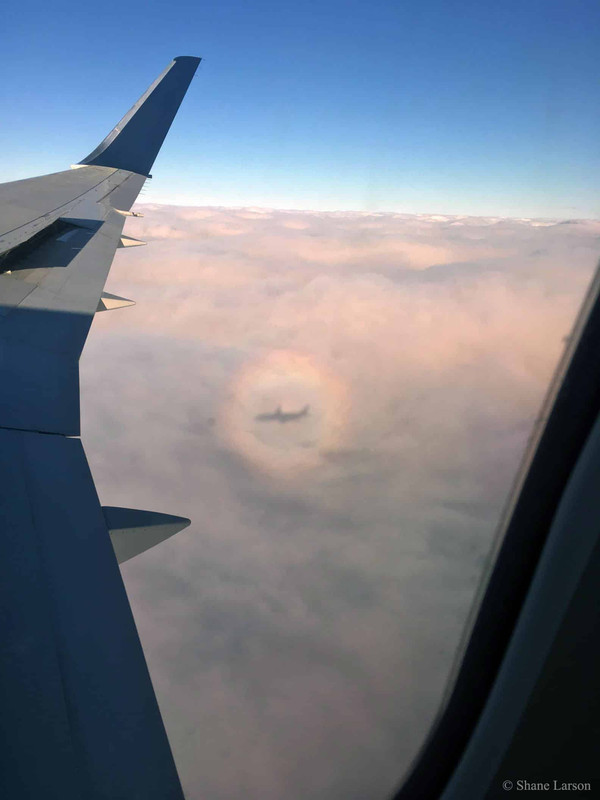
An Airplane Glory
Image Credit & Copyright: Shane Larson (Adler Planetarium, CIERA-Northwestern)
Explanation: Looking out the window of an airplane, you might be lucky enough to see "the glory" in the direction directly opposite the Sun. Before airplanes, the phenomenon, known to some as the heiligenschein or the Specter of the Brocken, was sometimes seen from mountaintops. There, when conditions were right, one could look away from the Sun and see what appeared to be the shadow of a giant surrounded by a bright halo. The giant turns out to be the observer, as in the modern version a silhouette of an plane frequently occupies the glory's center. This bright glory was photographed two weeks ago over Michigan from an airplane on approach to O'Hare International Airport. The cause of the glory is still being researched and is relatively complex. Surely, small droplets of water in some way reflect, refract, and diffract sunlight backwards towards the Sun. The phenomenon has similar counterparts in other branches of science including astronomy, where looking out from the Earth in the direction opposite the Sun yields a bright spot called the gegenschein.

An Airplane Glory
Image Credit & Copyright: Shane Larson (Adler Planetarium, CIERA-Northwestern)
Explanation: Looking out the window of an airplane, you might be lucky enough to see "the glory" in the direction directly opposite the Sun. Before airplanes, the phenomenon, known to some as the heiligenschein or the Specter of the Brocken, was sometimes seen from mountaintops. There, when conditions were right, one could look away from the Sun and see what appeared to be the shadow of a giant surrounded by a bright halo. The giant turns out to be the observer, as in the modern version a silhouette of an plane frequently occupies the glory's center. This bright glory was photographed two weeks ago over Michigan from an airplane on approach to O'Hare International Airport. The cause of the glory is still being researched and is relatively complex. Surely, small droplets of water in some way reflect, refract, and diffract sunlight backwards towards the Sun. The phenomenon has similar counterparts in other branches of science including astronomy, where looking out from the Earth in the direction opposite the Sun yields a bright spot called the gegenschein.

panosol- Αριθμός μηνυμάτων : 762
Points : 927
Reputation : 15
Ημερομηνία εγγραφής : 17/06/2012
Ηλικία : 56
 2016 December 23
2016 December 23
2016 December 23
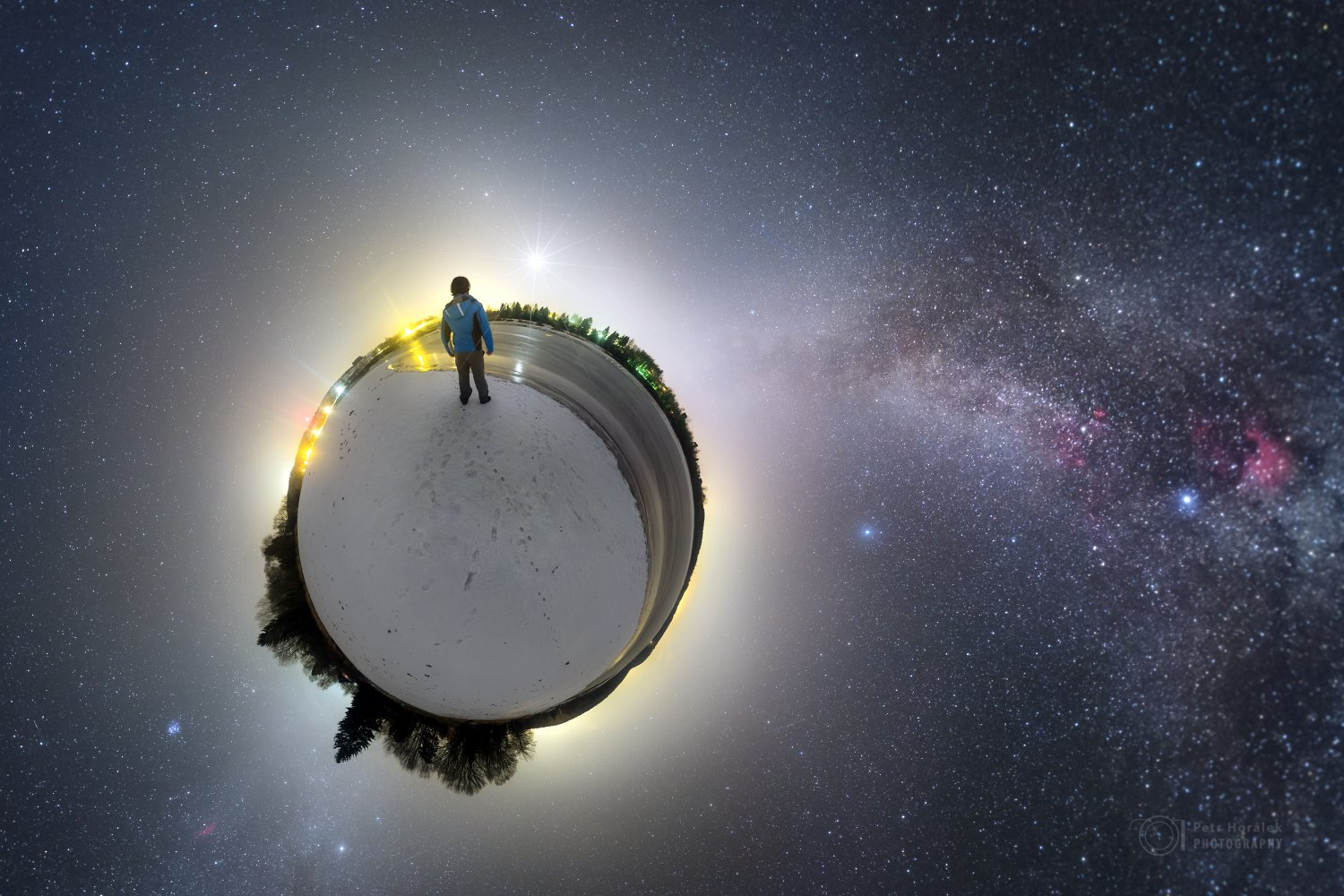
Once Upon a Solstice Eve
Image Credit & Copyright: Petr Horálek
Explanation: Once upon a solstice eve a little prince gazed across a frozen little planet at the edge of a large galaxy. The little planet was planet Earth of course, seen in this horizon to horizon, nadir to zenith projection, a digitally stitched mosaic from the shores of the Sec reservoir in the Czech Republic. So the large galaxy must be the Milky Way, and the brightest beacon on the planet's horizon Venus, visible around the globe as this season's brilliant evening star. Celestial treasures in surrounding dark skies include the Pleiades star cluster, and the North America nebula found along a dusty galactic rift. Embracing Venus, Zodiacal light traces a faint band across the night, but the more colorful pillars of light shine above streets a little closer to home.

Once Upon a Solstice Eve
Image Credit & Copyright: Petr Horálek
Explanation: Once upon a solstice eve a little prince gazed across a frozen little planet at the edge of a large galaxy. The little planet was planet Earth of course, seen in this horizon to horizon, nadir to zenith projection, a digitally stitched mosaic from the shores of the Sec reservoir in the Czech Republic. So the large galaxy must be the Milky Way, and the brightest beacon on the planet's horizon Venus, visible around the globe as this season's brilliant evening star. Celestial treasures in surrounding dark skies include the Pleiades star cluster, and the North America nebula found along a dusty galactic rift. Embracing Venus, Zodiacal light traces a faint band across the night, but the more colorful pillars of light shine above streets a little closer to home.

panosol- Αριθμός μηνυμάτων : 762
Points : 927
Reputation : 15
Ημερομηνία εγγραφής : 17/06/2012
Ηλικία : 56
 2016 December 24
2016 December 24
2016 December 24

Fox Fur, Unicorn, and Christmas Tree
Image Credit & Copyright: Michael Miller, Jimmy Walker
Explanation: Clouds of glowing hydrogen gas fill this colorful skyscape in the faint but fanciful constellation Monoceros, the Unicorn. A star forming region cataloged as NGC 2264, the complex jumble of cosmic gas and dust is about 2,700 light-years distant and mixes reddish emission nebulae excited by energetic light from newborn stars with dark interstellar dust clouds. Where the otherwise obscuring dust clouds lie close to the hot, young stars they also reflect starlight, forming blue reflection nebulae. The tall, telescopic mosaic image stands up about 3/4 degree or nearly 1.5 full moons, covering 40 light-years at the distance of NGC 2264. Its cast of cosmic characters includes the the Fox Fur Nebula, whose dusty, convoluted pelt lies just left of center, bright variable star S Monocerotis immersed in the blue-tinted haze right of the Fox Fur, and the Cone Nebula pointing down from the top of the frame. Of course, the stars of NGC 2264 are also known as the Christmas Tree star cluster. The triangular tree shape traced by the stars has its apex at the Cone Nebula. The tree's broader base is centered near S Monocerotis.

Fox Fur, Unicorn, and Christmas Tree
Image Credit & Copyright: Michael Miller, Jimmy Walker
Explanation: Clouds of glowing hydrogen gas fill this colorful skyscape in the faint but fanciful constellation Monoceros, the Unicorn. A star forming region cataloged as NGC 2264, the complex jumble of cosmic gas and dust is about 2,700 light-years distant and mixes reddish emission nebulae excited by energetic light from newborn stars with dark interstellar dust clouds. Where the otherwise obscuring dust clouds lie close to the hot, young stars they also reflect starlight, forming blue reflection nebulae. The tall, telescopic mosaic image stands up about 3/4 degree or nearly 1.5 full moons, covering 40 light-years at the distance of NGC 2264. Its cast of cosmic characters includes the the Fox Fur Nebula, whose dusty, convoluted pelt lies just left of center, bright variable star S Monocerotis immersed in the blue-tinted haze right of the Fox Fur, and the Cone Nebula pointing down from the top of the frame. Of course, the stars of NGC 2264 are also known as the Christmas Tree star cluster. The triangular tree shape traced by the stars has its apex at the Cone Nebula. The tree's broader base is centered near S Monocerotis.

panosol- Αριθμός μηνυμάτων : 762
Points : 927
Reputation : 15
Ημερομηνία εγγραφής : 17/06/2012
Ηλικία : 56
 2016 December 25
2016 December 25
2016 December 25
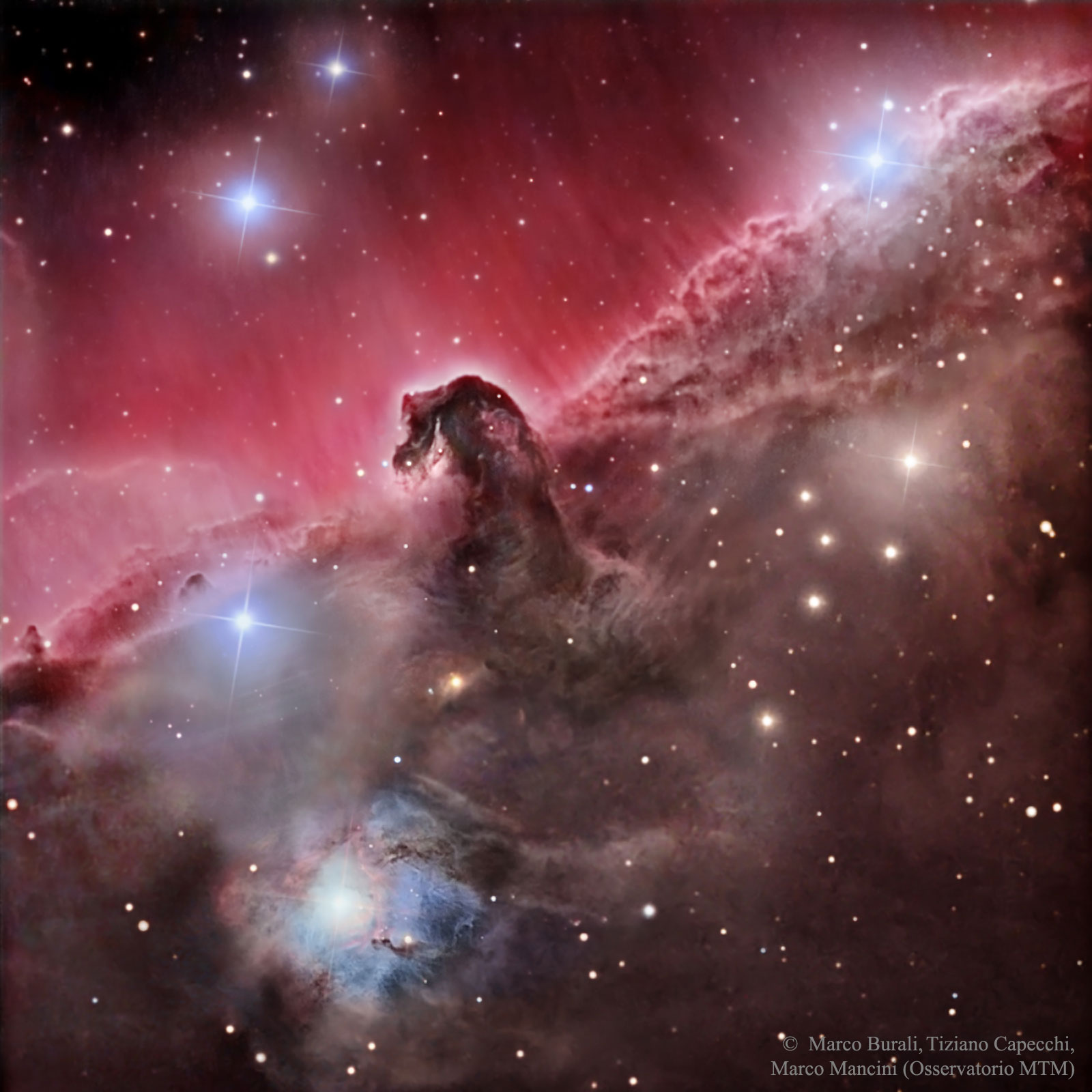
The Magnificent Horsehead Nebula
Image Credit & Copyright: Marco Burali, Tiziano Capecchi, Marco Mancini (Osservatorio MTM)
Explanation: Sculpted by stellar winds and radiation, a magnificent interstellar dust cloud by chance has assumed this recognizable shape. Fittingly named the Horsehead Nebula, it is some 1,500 light-years distant, embedded in the vast Orion cloud complex. About five light-years "tall", the dark cloud is cataloged as Barnard 33 and is visible only because its obscuring dust is silhouetted against the glowing red emission nebula IC 434. Stars are forming within the dark cloud. Contrasting blue reflection nebula NGC 2023, surrounding a hot, young star, is at the lower left. The gorgeous color image combines both narrowband and broadband images recorded using three different telescopes.

The Magnificent Horsehead Nebula
Image Credit & Copyright: Marco Burali, Tiziano Capecchi, Marco Mancini (Osservatorio MTM)
Explanation: Sculpted by stellar winds and radiation, a magnificent interstellar dust cloud by chance has assumed this recognizable shape. Fittingly named the Horsehead Nebula, it is some 1,500 light-years distant, embedded in the vast Orion cloud complex. About five light-years "tall", the dark cloud is cataloged as Barnard 33 and is visible only because its obscuring dust is silhouetted against the glowing red emission nebula IC 434. Stars are forming within the dark cloud. Contrasting blue reflection nebula NGC 2023, surrounding a hot, young star, is at the lower left. The gorgeous color image combines both narrowband and broadband images recorded using three different telescopes.

panosol- Αριθμός μηνυμάτων : 762
Points : 927
Reputation : 15
Ημερομηνία εγγραφής : 17/06/2012
Ηλικία : 56
 2016 December 26
2016 December 26
2016 December 26
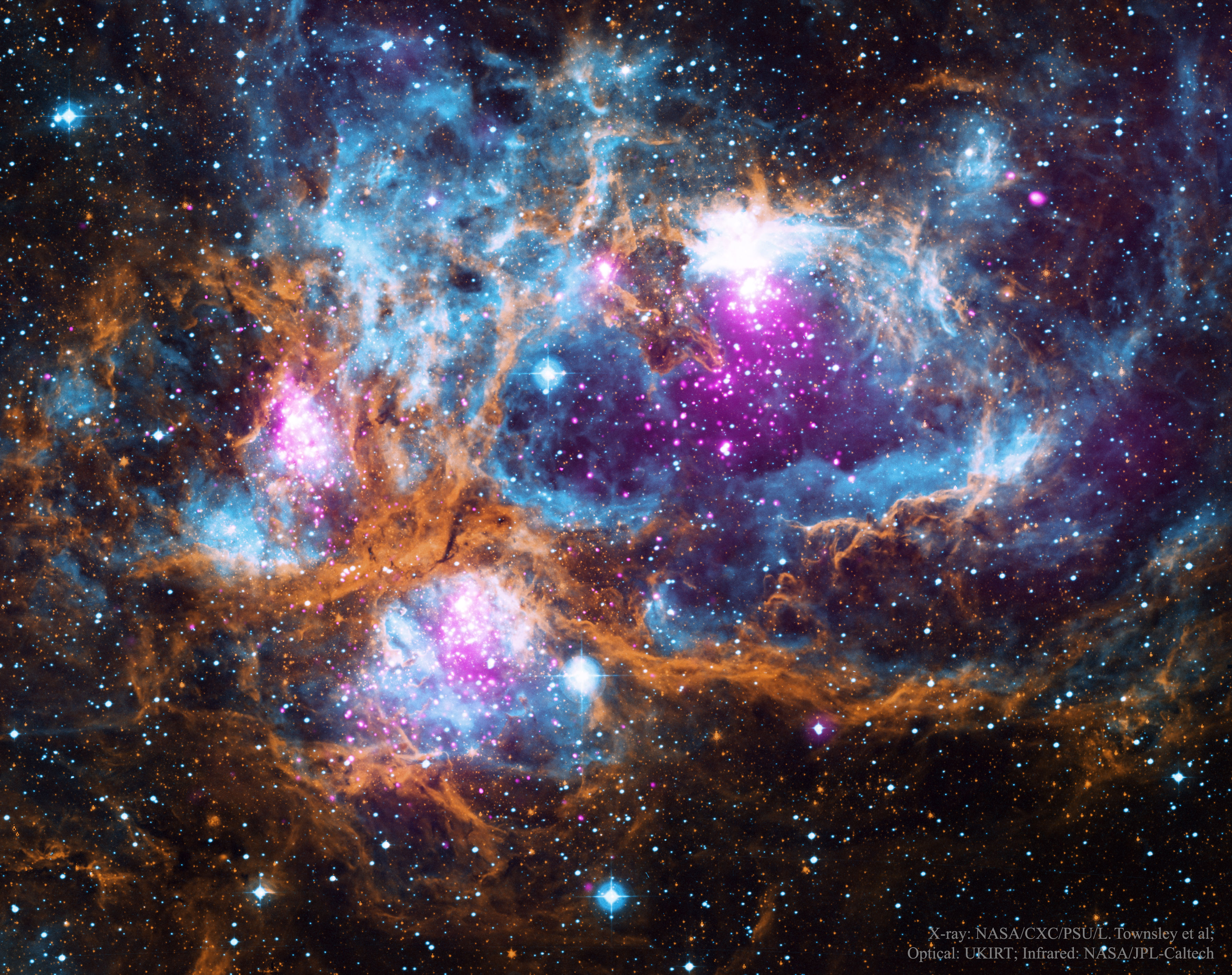
NGC 6357: Stellar Wonderland
Image Credit: X-ray: NASA/CXC/PSU/L. Townsley et al; Optical: UKIRT; Infrared: NASA/JPL-Caltech
Explanation: For reasons unknown, NGC 6357 is forming some of the most massive stars ever discovered. This complex wonderland of star formation consists of numerous filaments of dust and gas surrounding huge cavities of massive star clusters. The intricate patterns are caused by complex interactions between interstellar winds, radiation pressures, magnetic fields, and gravity. The featured image includes not only visible light taken by the UKIRT Telescope in Hawaii (blue) as part of the SuperCosmos Sky Surveys, but infrared light from NASA's orbiting Spitzer Space Telescope (orange) and X-ray light from NASA's orbiting Chandra X-ray Observatory (pink). NGC 6357 spans about 100 light years and lies about 5,500 light years away toward the constellation of the Scorpion. Within 10 million years, the most massive stars currently seen in NGC 6357 will have exploded.

NGC 6357: Stellar Wonderland
Image Credit: X-ray: NASA/CXC/PSU/L. Townsley et al; Optical: UKIRT; Infrared: NASA/JPL-Caltech
Explanation: For reasons unknown, NGC 6357 is forming some of the most massive stars ever discovered. This complex wonderland of star formation consists of numerous filaments of dust and gas surrounding huge cavities of massive star clusters. The intricate patterns are caused by complex interactions between interstellar winds, radiation pressures, magnetic fields, and gravity. The featured image includes not only visible light taken by the UKIRT Telescope in Hawaii (blue) as part of the SuperCosmos Sky Surveys, but infrared light from NASA's orbiting Spitzer Space Telescope (orange) and X-ray light from NASA's orbiting Chandra X-ray Observatory (pink). NGC 6357 spans about 100 light years and lies about 5,500 light years away toward the constellation of the Scorpion. Within 10 million years, the most massive stars currently seen in NGC 6357 will have exploded.

panosol- Αριθμός μηνυμάτων : 762
Points : 927
Reputation : 15
Ημερομηνία εγγραφής : 17/06/2012
Ηλικία : 56
 2016 December 27
2016 December 27
2016 December 27

M31: The Andromeda Galaxy
Image Credit & Copyright: Farmakopoulos Antonis
Explanation: What is the nearest major galaxy to our own Milky Way Galaxy? Andromeda. In fact, our Galaxy is thought to look much like Andromeda. Together these two galaxies dominate the Local Group of galaxies. The diffuse light from Andromeda is caused by the hundreds of billions of stars that compose it. The several distinct stars that surround Andromeda's image are actually stars in our Galaxy that are well in front of the background object. Andromeda is frequently referred to as M31 since it is the 31st object on Messier's list of diffuse sky objects. M31 is so distant it takes about two million years for light to reach us from there. Although visible without aid, the featured image of M31 is a digital mosaic of several frames taken with a small telescope. Much about M31 remains unknown, including exactly how many billions of years it will before it collides with our home galaxy.

M31: The Andromeda Galaxy
Image Credit & Copyright: Farmakopoulos Antonis
Explanation: What is the nearest major galaxy to our own Milky Way Galaxy? Andromeda. In fact, our Galaxy is thought to look much like Andromeda. Together these two galaxies dominate the Local Group of galaxies. The diffuse light from Andromeda is caused by the hundreds of billions of stars that compose it. The several distinct stars that surround Andromeda's image are actually stars in our Galaxy that are well in front of the background object. Andromeda is frequently referred to as M31 since it is the 31st object on Messier's list of diffuse sky objects. M31 is so distant it takes about two million years for light to reach us from there. Although visible without aid, the featured image of M31 is a digital mosaic of several frames taken with a small telescope. Much about M31 remains unknown, including exactly how many billions of years it will before it collides with our home galaxy.

panosol- Αριθμός μηνυμάτων : 762
Points : 927
Reputation : 15
Ημερομηνία εγγραφής : 17/06/2012
Ηλικία : 56
 2016 December 28
2016 December 28
2016 December 28

Curiosity Surveys Lower Mount Sharp on Mars
Image Credit: NASA, JPL-Caltech, MSSS;
Explanation: If you could stand on Mars -- what might you see? If you were the Curiosity rover, then just last month you would have contemplated the featured image -- a breathtaking panorama of the lower portion of Mount Sharp. The colors have been adjusted to mimic lighting familiar to Earthlings. Surveyed here was a rocky plain before increasingly high rolling hills. The rounded hills in the middle distance, called the Sulfate Unit, are Curiosity's highest currently planned destination. One reason these hills are interesting is because sulfates are an energy source for some micro-organisms. The immediate path forward, though, was toward the southeast on the left part of the image.

Curiosity Surveys Lower Mount Sharp on Mars
Image Credit: NASA, JPL-Caltech, MSSS;
Explanation: If you could stand on Mars -- what might you see? If you were the Curiosity rover, then just last month you would have contemplated the featured image -- a breathtaking panorama of the lower portion of Mount Sharp. The colors have been adjusted to mimic lighting familiar to Earthlings. Surveyed here was a rocky plain before increasingly high rolling hills. The rounded hills in the middle distance, called the Sulfate Unit, are Curiosity's highest currently planned destination. One reason these hills are interesting is because sulfates are an energy source for some micro-organisms. The immediate path forward, though, was toward the southeast on the left part of the image.

panosol- Αριθμός μηνυμάτων : 762
Points : 927
Reputation : 15
Ημερομηνία εγγραφής : 17/06/2012
Ηλικία : 56
 2016 December 29
2016 December 29
2016 December 29
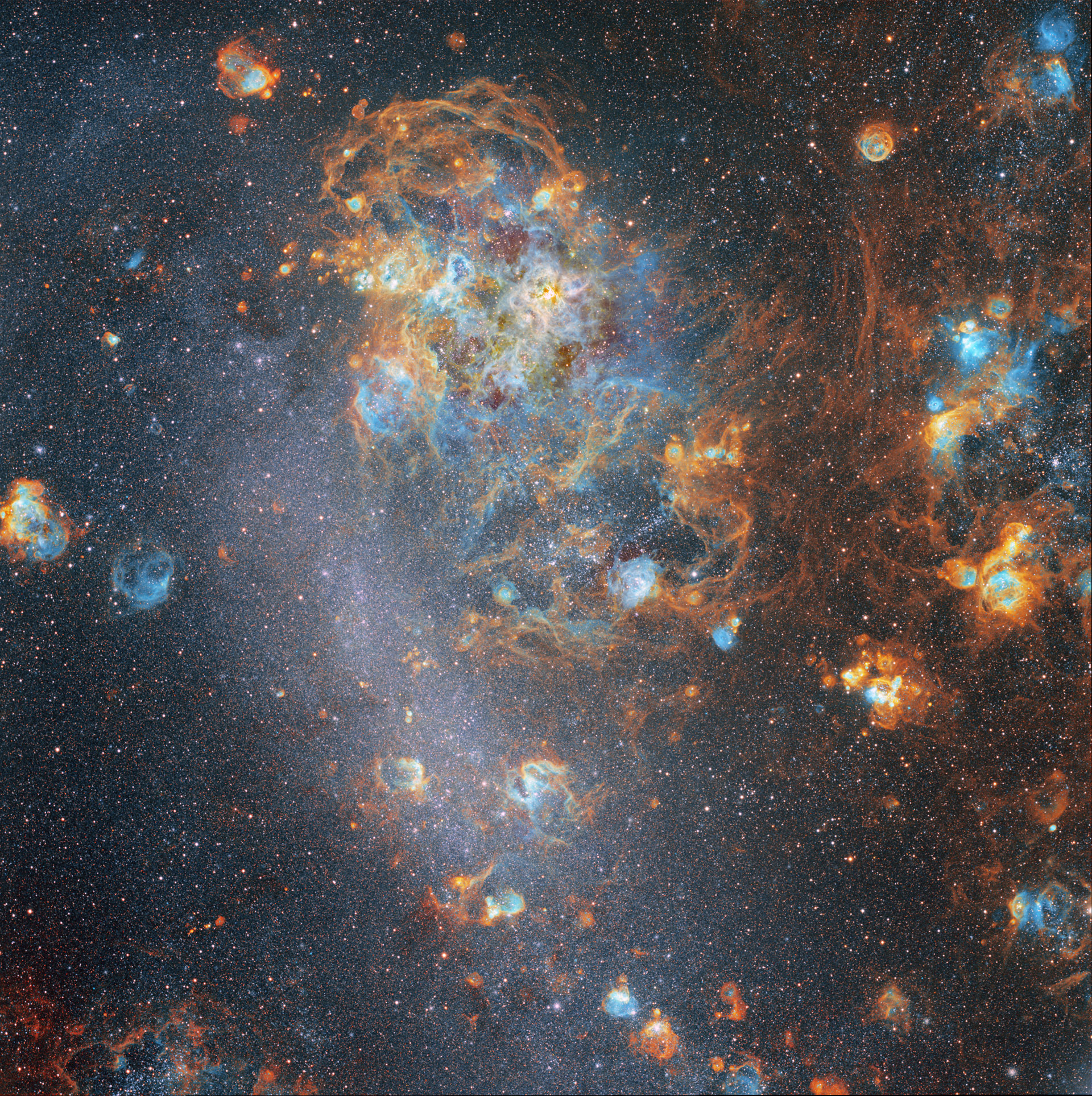
Shell Game in the LMC
Image Credit & Copyright: John Gleason
Explanation: An alluring sight in southern skies, the Large Magellanic Cloud (LMC) is seen here through narrowband filters. The filters are designed to transmit only light emitted by ionized sulfur, hydrogen, and oxygen atoms. Ionized by energetic starlight, the atoms emit their characteristic light as electrons are recaptured and the atom transitions to a lower energy state. As a result, this false color image of the LMC seems covered with shell-shaped clouds of ionized gas surrounding massive, young stars. Sculpted by the strong stellar winds and ultraviolet radiation, the glowing clouds, dominated by emission from hydrogen, are known as H II (ionized hydrogen) regions. Itself composed of many overlapping shells, the Tarantula Nebula is the large star forming region at top center. A satellite of our Milky Way Galaxy, the LMC is about 15,000 light-years across and lies a mere 180,000 light-years away in the constellation Dorado.

Shell Game in the LMC
Image Credit & Copyright: John Gleason
Explanation: An alluring sight in southern skies, the Large Magellanic Cloud (LMC) is seen here through narrowband filters. The filters are designed to transmit only light emitted by ionized sulfur, hydrogen, and oxygen atoms. Ionized by energetic starlight, the atoms emit their characteristic light as electrons are recaptured and the atom transitions to a lower energy state. As a result, this false color image of the LMC seems covered with shell-shaped clouds of ionized gas surrounding massive, young stars. Sculpted by the strong stellar winds and ultraviolet radiation, the glowing clouds, dominated by emission from hydrogen, are known as H II (ionized hydrogen) regions. Itself composed of many overlapping shells, the Tarantula Nebula is the large star forming region at top center. A satellite of our Milky Way Galaxy, the LMC is about 15,000 light-years across and lies a mere 180,000 light-years away in the constellation Dorado.

panosol- Αριθμός μηνυμάτων : 762
Points : 927
Reputation : 15
Ημερομηνία εγγραφής : 17/06/2012
Ηλικία : 56
 2016 December 30
2016 December 30
2016 December 30

Lunar Farside
Image Credit: NASA / GSFC / Arizona State Univ. / Lunar Reconnaissance Orbiter
Explanation: Tidally locked in synchronous rotation, the Moon always presents its familiar nearside to denizens of planet Earth. From lunar orbit, the Moon's farside can become familiar, though. In fact this sharp picture, a mosaic from the Lunar Reconnaissance Orbiter's wide angle camera, is centered on the lunar farside. Part of a global mosaic of over 15,000 images acquired between November 2009 and February 2011, the highest resolution version shows features at a scale of 100 meters per pixel. Surprisingly, the rough and battered surface of the farside looks very different from the nearside covered with smooth dark lunar maria. The likely explanation is that the farside crust is thicker, making it harder for molten material from the interior to flow to the surface and form the smooth maria.

Lunar Farside
Image Credit: NASA / GSFC / Arizona State Univ. / Lunar Reconnaissance Orbiter
Explanation: Tidally locked in synchronous rotation, the Moon always presents its familiar nearside to denizens of planet Earth. From lunar orbit, the Moon's farside can become familiar, though. In fact this sharp picture, a mosaic from the Lunar Reconnaissance Orbiter's wide angle camera, is centered on the lunar farside. Part of a global mosaic of over 15,000 images acquired between November 2009 and February 2011, the highest resolution version shows features at a scale of 100 meters per pixel. Surprisingly, the rough and battered surface of the farside looks very different from the nearside covered with smooth dark lunar maria. The likely explanation is that the farside crust is thicker, making it harder for molten material from the interior to flow to the surface and form the smooth maria.

panosol- Αριθμός μηνυμάτων : 762
Points : 927
Reputation : 15
Ημερομηνία εγγραφής : 17/06/2012
Ηλικία : 56
 2016 December 31
2016 December 31
2016 December 31
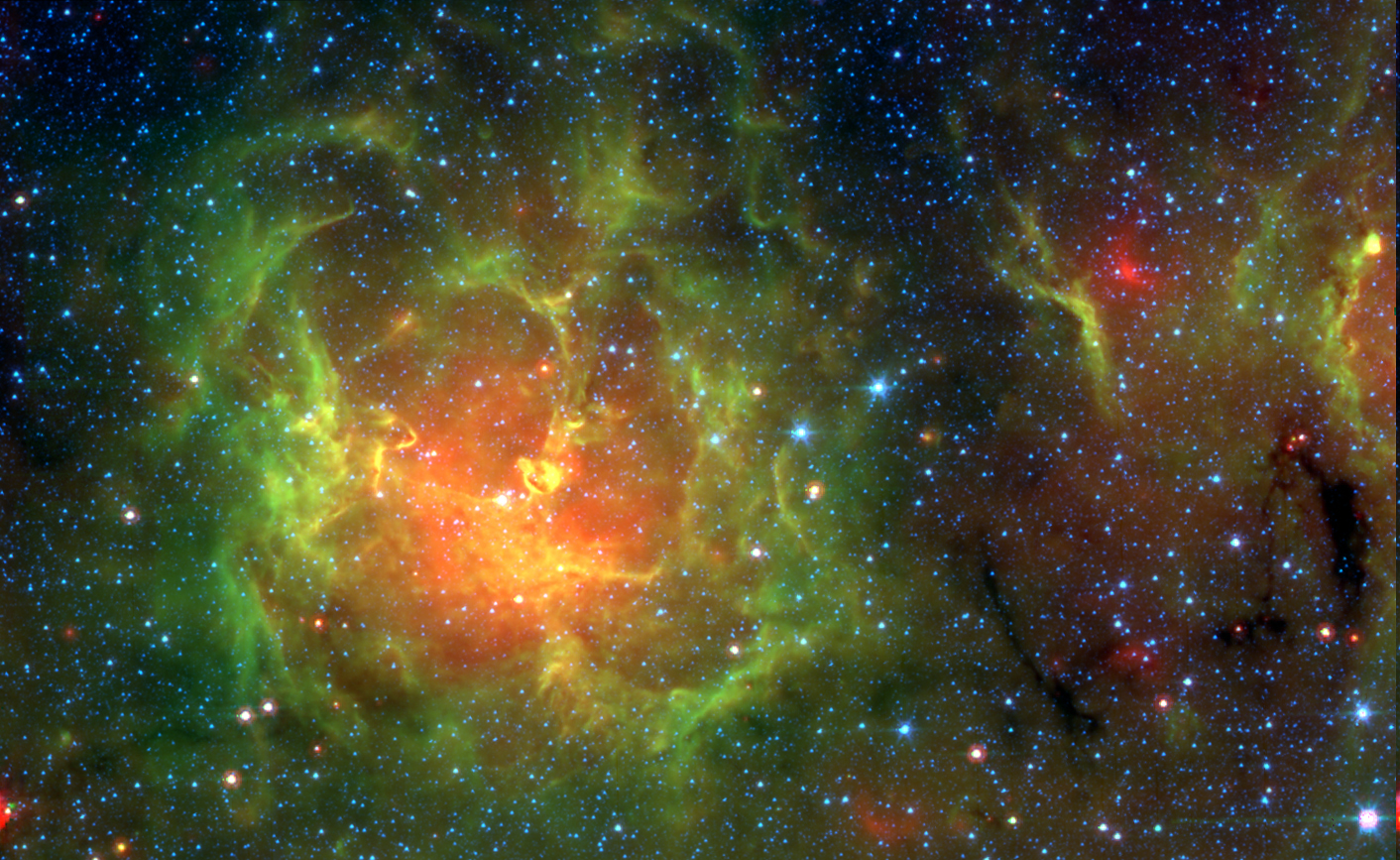
Infrared Trifid
Image Credit: J. Rho (SSC/Caltech), JPL-Caltech, NASA
Explanation: The Trifid Nebula, also known as Messier 20, is easy to find with a small telescope, a well known stop in the nebula rich constellation Sagittarius. But where visible light pictures show the nebula divided into three parts by dark, obscuring dust lanes, this penetrating infrared image reveals filaments of glowing dust clouds and newborn stars. The spectacular false-color view is courtesy of the Spitzer Space Telescope. Astronomers have used the Spitzer infrared image data to count newborn and embryonic stars which otherwise can lie hidden in the natal dust and gas clouds of this intriguing stellar nursery. As seen here, the Trifid is about 30 light-years across and lies only 5,500 light-years away.

Infrared Trifid
Image Credit: J. Rho (SSC/Caltech), JPL-Caltech, NASA
Explanation: The Trifid Nebula, also known as Messier 20, is easy to find with a small telescope, a well known stop in the nebula rich constellation Sagittarius. But where visible light pictures show the nebula divided into three parts by dark, obscuring dust lanes, this penetrating infrared image reveals filaments of glowing dust clouds and newborn stars. The spectacular false-color view is courtesy of the Spitzer Space Telescope. Astronomers have used the Spitzer infrared image data to count newborn and embryonic stars which otherwise can lie hidden in the natal dust and gas clouds of this intriguing stellar nursery. As seen here, the Trifid is about 30 light-years across and lies only 5,500 light-years away.

panosol- Αριθμός μηνυμάτων : 762
Points : 927
Reputation : 15
Ημερομηνία εγγραφής : 17/06/2012
Ηλικία : 56
 2017 January 1
2017 January 1
2017 January 1
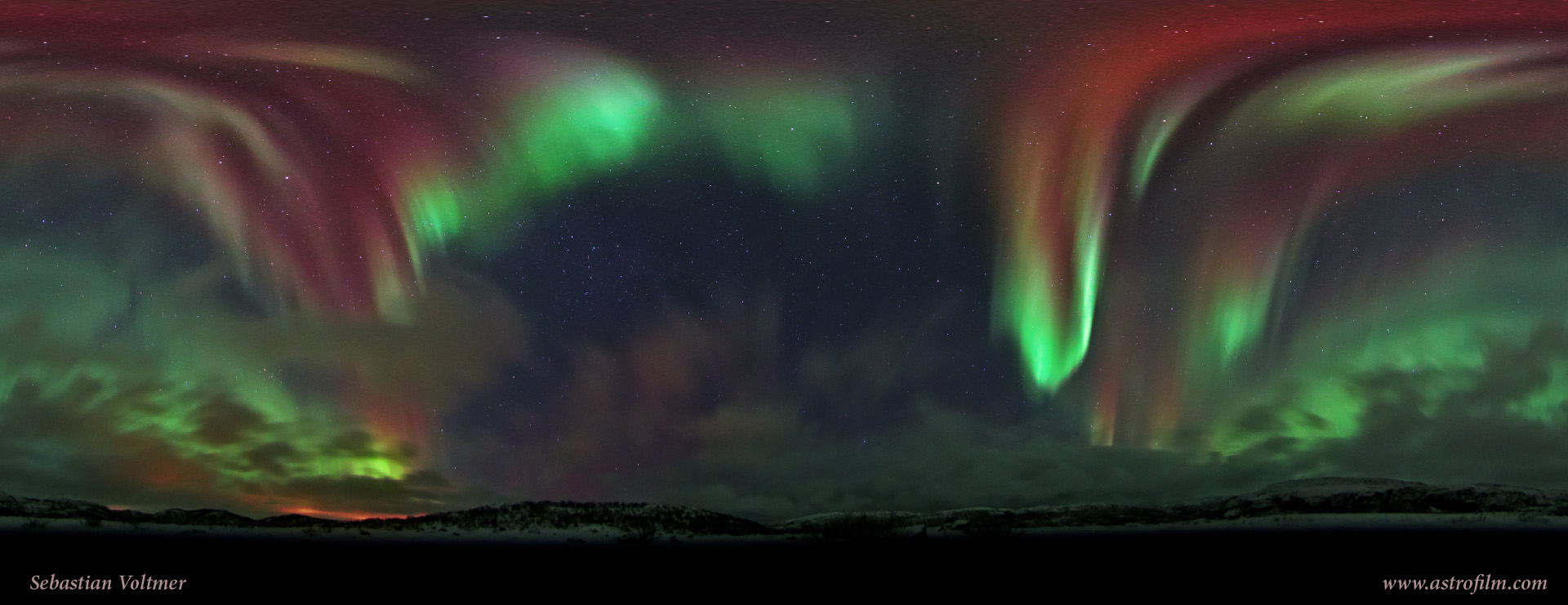
A Full Sky Aurora Over Norway
Image Credit & Copyright: Sebastian Voltmer
Explanation: Higher than the highest building, higher than the highest mountain, higher than the highest airplane, lies the realm of the aurora. Auroras rarely reach below 60 kilometers, and can range up to 1000 kilometers. Aurora light results from energetic electrons and protons striking molecules in the Earth's atmosphere. Frequently, when viewed from space, a complete aurora will appear as a circle around one of the Earth's magnetic poles. The featured wide-angle image, horizontally compressed, captured an unexpected auroral display that stretched across the sky five years ago over eastern Norway.

A Full Sky Aurora Over Norway
Image Credit & Copyright: Sebastian Voltmer
Explanation: Higher than the highest building, higher than the highest mountain, higher than the highest airplane, lies the realm of the aurora. Auroras rarely reach below 60 kilometers, and can range up to 1000 kilometers. Aurora light results from energetic electrons and protons striking molecules in the Earth's atmosphere. Frequently, when viewed from space, a complete aurora will appear as a circle around one of the Earth's magnetic poles. The featured wide-angle image, horizontally compressed, captured an unexpected auroral display that stretched across the sky five years ago over eastern Norway.

panosol- Αριθμός μηνυμάτων : 762
Points : 927
Reputation : 15
Ημερομηνία εγγραφής : 17/06/2012
Ηλικία : 56
 2017 January 2
2017 January 2
2017 January 2
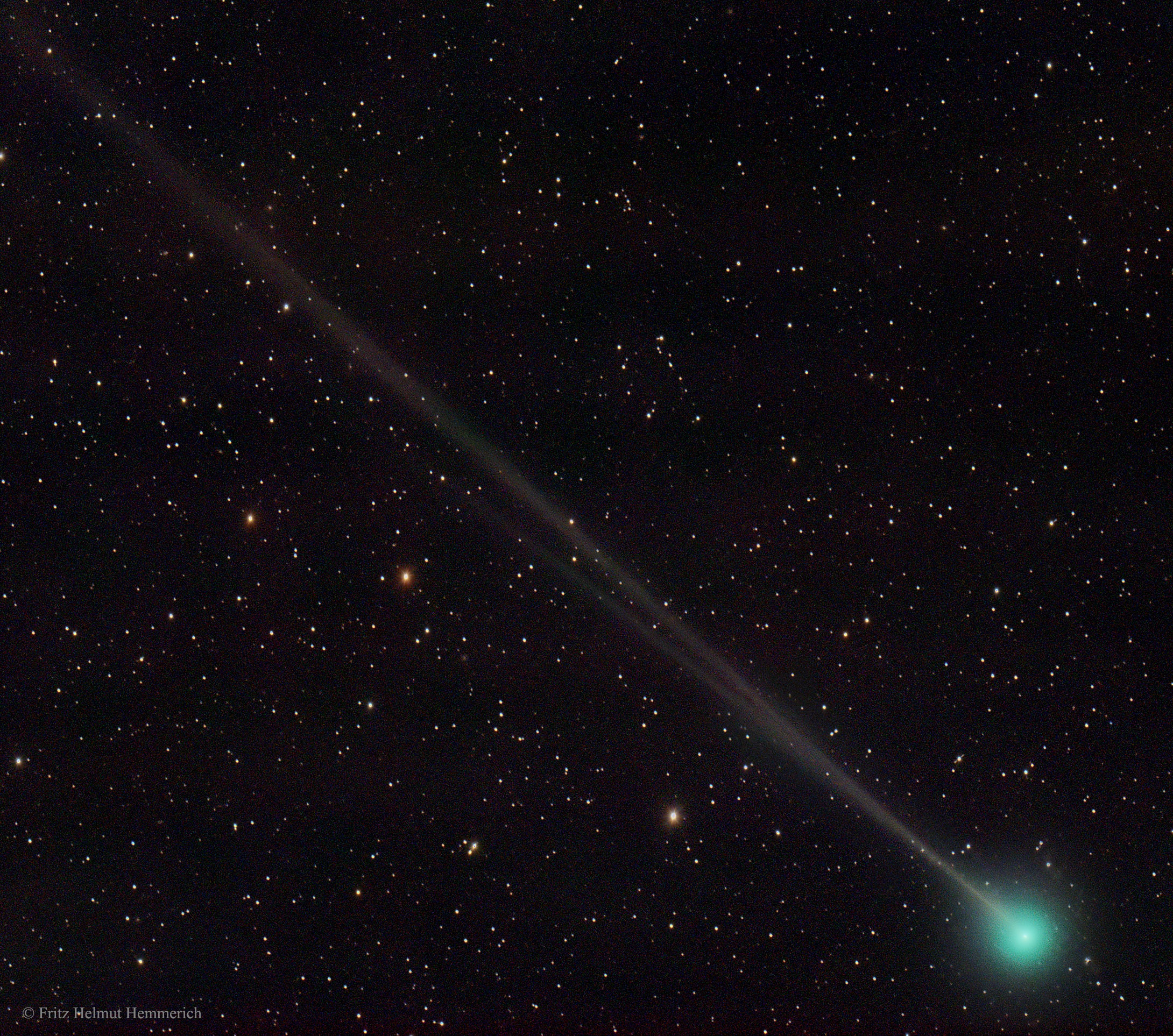
Comet 45P Returns
Image Credit & Copyright: Fritz Helmut Hemmerich
Explanation: An old comet has returned to the inner Solar System. Not only is Comet 45P/Honda–Mrkos–Pajdušáková physically ancient, it was first discovered 13 orbits ago in 1948. Comet 45P spends most of its time out near the orbit of Jupiter and last neared the Sun in 2011. Over the past few months, however, Comet 45P's new sunward plummet has brightened it considerably. Two days ago, the comet passed the closest part of its orbit to the Sun. The comet is currently visible with binoculars over the western horizon just after sunset, not far from the much brighter planet Venus. Pictured, Comet 45P was captured last week sporting a long ion tail with impressive structure. Comet 45P will pass relatively close to the Earth early next month.

Comet 45P Returns
Image Credit & Copyright: Fritz Helmut Hemmerich
Explanation: An old comet has returned to the inner Solar System. Not only is Comet 45P/Honda–Mrkos–Pajdušáková physically ancient, it was first discovered 13 orbits ago in 1948. Comet 45P spends most of its time out near the orbit of Jupiter and last neared the Sun in 2011. Over the past few months, however, Comet 45P's new sunward plummet has brightened it considerably. Two days ago, the comet passed the closest part of its orbit to the Sun. The comet is currently visible with binoculars over the western horizon just after sunset, not far from the much brighter planet Venus. Pictured, Comet 45P was captured last week sporting a long ion tail with impressive structure. Comet 45P will pass relatively close to the Earth early next month.

panosol- Αριθμός μηνυμάτων : 762
Points : 927
Reputation : 15
Ημερομηνία εγγραφής : 17/06/2012
Ηλικία : 56
 2017 January 3
2017 January 3
2017 January 3
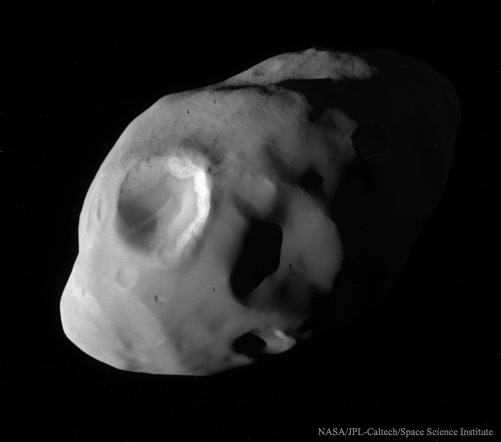
Pandora Close-up at Saturn
Image Credit: NASA, JPL-Caltech, Space Science Institute
Explanation: What do the craters of Saturn's small moon Pandora look like up close? To help find out, NASA sent the robotic Cassini spacecraft, now orbiting Saturn, past the unusual moon two weeks ago. The highest resolution image of Pandora ever taken was then captured from about 40,000 kilometers out and is featured here. Structures as small as 300 meters can be discerned on 80-kilometer wide Pandora. Craters on Pandora appear to be covered over by some sort of material, providing a more smooth appearance than sponge-like Hyperion, another small moon of Saturn. Curious grooves and ridges also appear to cross the surface of the small moon. Pandora is partly interesting because, along with its companion moon Prometheus, it helps shepherd the particles of Saturn's F ring into a distinct ring.

Pandora Close-up at Saturn
Image Credit: NASA, JPL-Caltech, Space Science Institute
Explanation: What do the craters of Saturn's small moon Pandora look like up close? To help find out, NASA sent the robotic Cassini spacecraft, now orbiting Saturn, past the unusual moon two weeks ago. The highest resolution image of Pandora ever taken was then captured from about 40,000 kilometers out and is featured here. Structures as small as 300 meters can be discerned on 80-kilometer wide Pandora. Craters on Pandora appear to be covered over by some sort of material, providing a more smooth appearance than sponge-like Hyperion, another small moon of Saturn. Curious grooves and ridges also appear to cross the surface of the small moon. Pandora is partly interesting because, along with its companion moon Prometheus, it helps shepherd the particles of Saturn's F ring into a distinct ring.

panosol- Αριθμός μηνυμάτων : 762
Points : 927
Reputation : 15
Ημερομηνία εγγραφής : 17/06/2012
Ηλικία : 56
 2017 January 4
2017 January 4
2017 January 4

Clouds of Andromeda
Image Credit & Copyright: Rogelio Bernal Andreo (Deep Sky Colors)
Explanation: The beautiful Andromeda Galaxy is often imaged by planet Earth-based astronomers. Also known as M31, the nearest large spiral galaxy is a familiar sight with dark dust lanes, bright yellowish core, and spiral arms traced by blue starlight. A mosaic of well-exposed broad and narrow-band image data, this colorful, premier portrait of our neighboring island universe offers strikingly unfamiliar features though, faint reddish clouds of glowing ionized hydrogen gas in the same wide field of view. Still, the ionized hydrogen clouds likely lie in the foreground of the scene, well within our Milky Way Galaxy. They could be associated with the pervasive, dusty interstellar cirrus clouds scattered hundreds of light-years above our own galactic plane. If they were located at the 2.5 million light-year distance of the Andromeda Galaxy they would be enormous, since the Andromeda Galaxy itself is 200,000 or so light-years across.

Clouds of Andromeda
Image Credit & Copyright: Rogelio Bernal Andreo (Deep Sky Colors)
Explanation: The beautiful Andromeda Galaxy is often imaged by planet Earth-based astronomers. Also known as M31, the nearest large spiral galaxy is a familiar sight with dark dust lanes, bright yellowish core, and spiral arms traced by blue starlight. A mosaic of well-exposed broad and narrow-band image data, this colorful, premier portrait of our neighboring island universe offers strikingly unfamiliar features though, faint reddish clouds of glowing ionized hydrogen gas in the same wide field of view. Still, the ionized hydrogen clouds likely lie in the foreground of the scene, well within our Milky Way Galaxy. They could be associated with the pervasive, dusty interstellar cirrus clouds scattered hundreds of light-years above our own galactic plane. If they were located at the 2.5 million light-year distance of the Andromeda Galaxy they would be enormous, since the Andromeda Galaxy itself is 200,000 or so light-years across.

panosol- Αριθμός μηνυμάτων : 762
Points : 927
Reputation : 15
Ημερομηνία εγγραφής : 17/06/2012
Ηλικία : 56
 2017 January 5
2017 January 5
2017 January 5
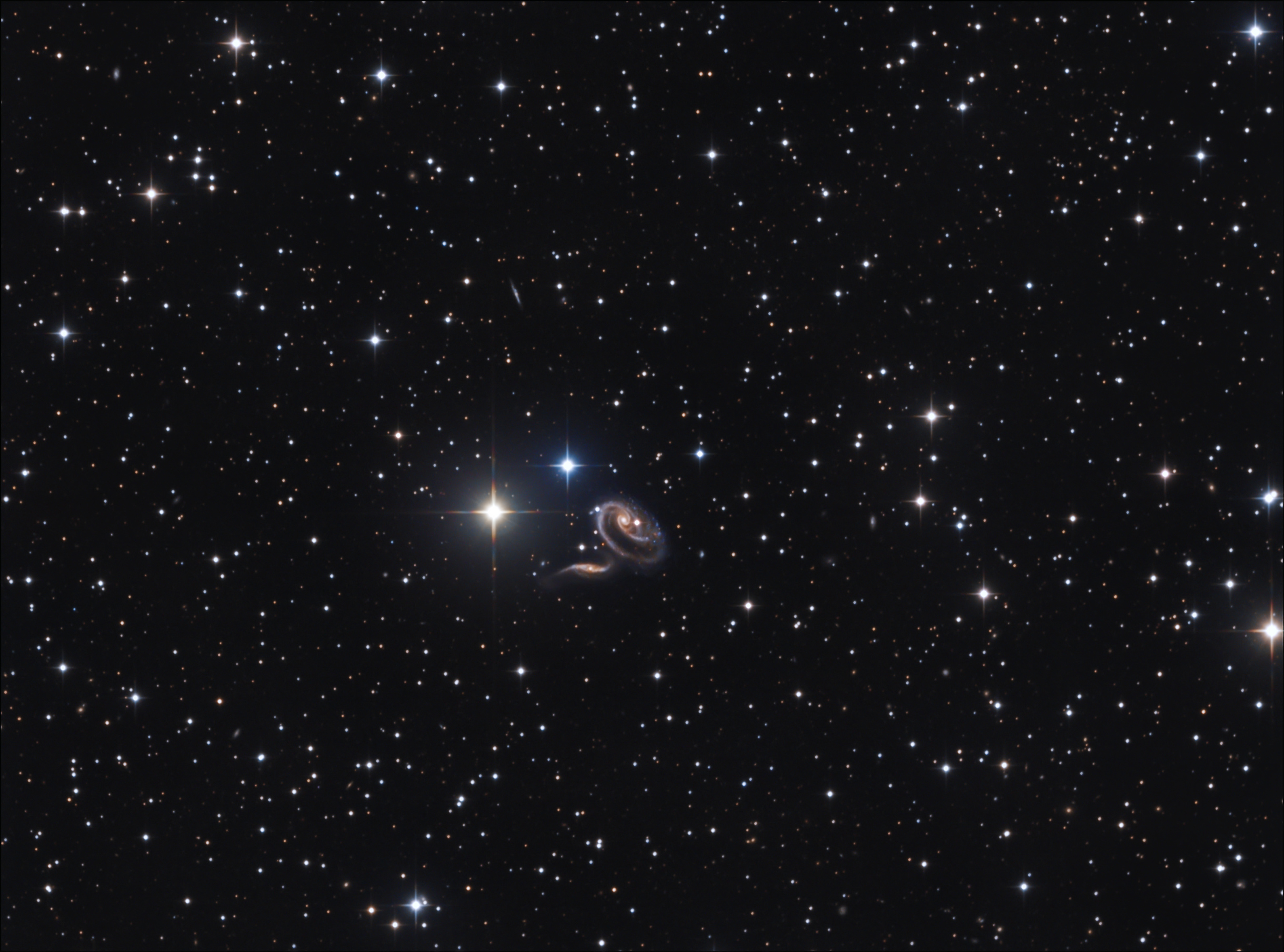
Peculiar Galaxies of Arp 273
Image Credit & Copyright: Wolfgang Ries/Stefan Heutz (Astrokooperation)
Explanation: The spiky stars in the foreground of this sharp cosmic portrait are well within our own Milky Way Galaxy. The two eye-catching galaxies lie far beyond the Milky Way, at a distance of over 300 million light-years. Their distorted appearance is due to gravitational tides as the pair engage in close encounters. Cataloged as Arp 273 (also as UGC 1810), the galaxies do look peculiar, but interacting galaxies are now understood to be common in the universe. In fact, the nearby large spiral Andromeda Galaxy is known to be some 2 million light-years away and approaching the Milky Way. Arp 273 may offer an analog of their far future encounter. Repeated galaxy encounters on a cosmic timescale can ultimately result in a merger into a single galaxy of stars. From our perspective, the bright cores of the Arp 273 galaxies are separated by only a little over 100,000 light-years.

Peculiar Galaxies of Arp 273
Image Credit & Copyright: Wolfgang Ries/Stefan Heutz (Astrokooperation)
Explanation: The spiky stars in the foreground of this sharp cosmic portrait are well within our own Milky Way Galaxy. The two eye-catching galaxies lie far beyond the Milky Way, at a distance of over 300 million light-years. Their distorted appearance is due to gravitational tides as the pair engage in close encounters. Cataloged as Arp 273 (also as UGC 1810), the galaxies do look peculiar, but interacting galaxies are now understood to be common in the universe. In fact, the nearby large spiral Andromeda Galaxy is known to be some 2 million light-years away and approaching the Milky Way. Arp 273 may offer an analog of their far future encounter. Repeated galaxy encounters on a cosmic timescale can ultimately result in a merger into a single galaxy of stars. From our perspective, the bright cores of the Arp 273 galaxies are separated by only a little over 100,000 light-years.

panosol- Αριθμός μηνυμάτων : 762
Points : 927
Reputation : 15
Ημερομηνία εγγραφής : 17/06/2012
Ηλικία : 56
 2017 January 6
2017 January 6
2017 January 6
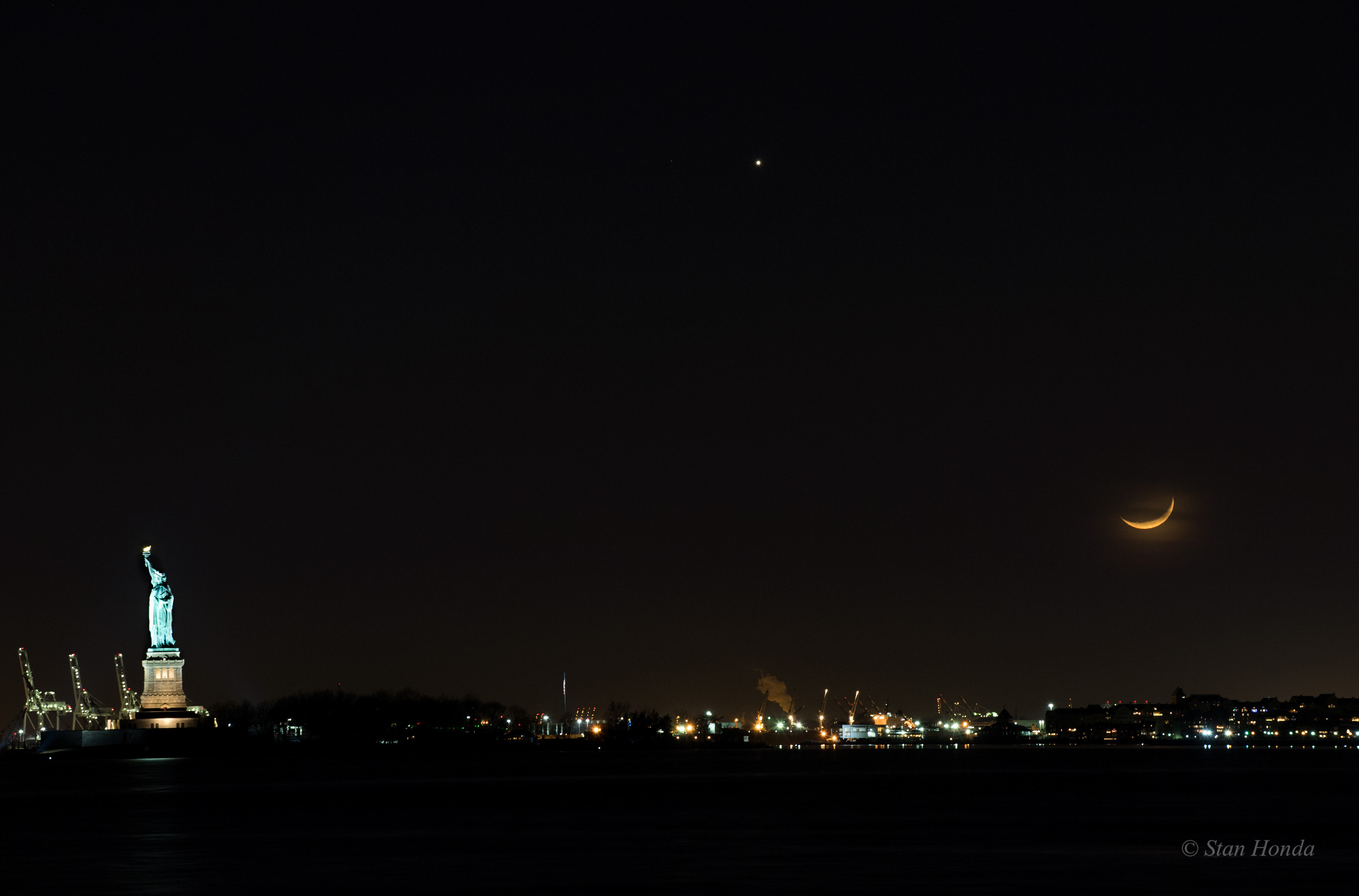
New York Harbor Moonset
Image Credit & Copyright: Stan Honda
Explanation: Moonset on January 1 is captured in this sea and night sky snapshot from the port city of New York. Its warm moonlight shining through haze and thin clouds, this New Year's Moon was about 3 days old, in a waxing crescent phase. The visible lunar disk is about 10 percent illuminated. Also easy to spot in hazy urban skies, Venus blazes forth over the western horizon, begining the year as Earth's evening star. Like the Moon, Venus goes through a range of phases as seen from planet Earth. As the year began, telescopic views of the brilliant inner planet's disk would show it about 50 percent illuminated, growing into a larger but thinner crescent by early March. New York Harbor's welcoming beacon, the Statue of Liberty, anchors a terrestrial corner of the night's triangle at the far left.

New York Harbor Moonset
Image Credit & Copyright: Stan Honda
Explanation: Moonset on January 1 is captured in this sea and night sky snapshot from the port city of New York. Its warm moonlight shining through haze and thin clouds, this New Year's Moon was about 3 days old, in a waxing crescent phase. The visible lunar disk is about 10 percent illuminated. Also easy to spot in hazy urban skies, Venus blazes forth over the western horizon, begining the year as Earth's evening star. Like the Moon, Venus goes through a range of phases as seen from planet Earth. As the year began, telescopic views of the brilliant inner planet's disk would show it about 50 percent illuminated, growing into a larger but thinner crescent by early March. New York Harbor's welcoming beacon, the Statue of Liberty, anchors a terrestrial corner of the night's triangle at the far left.

panosol- Αριθμός μηνυμάτων : 762
Points : 927
Reputation : 15
Ημερομηνία εγγραφής : 17/06/2012
Ηλικία : 56
 2017 January 7
2017 January 7
2017 January 7
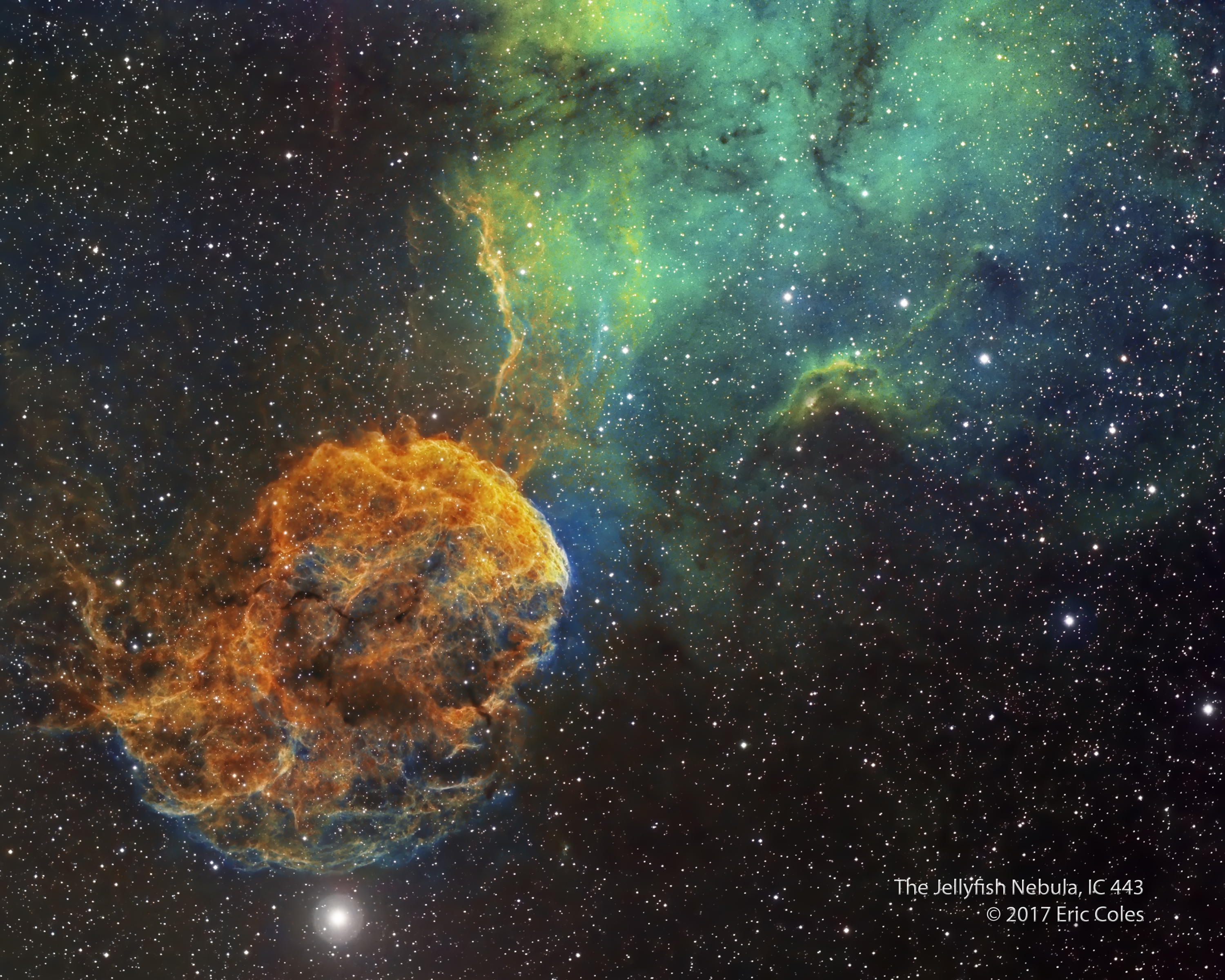
Sharpless 249 and the Jellyfish Nebula
Image Credit & Copyright: Eric Coles
Explanation: Normally faint and elusive, the Jellyfish Nebula is caught in this alluring telescopic mosaic. The scene is anchored below by bright star Eta Geminorum, at the foot of the celestial twin, while the Jellyfish Nebula is the brighter arcing ridge of emission with tentacles dangling below and left of center. In fact, the cosmic jellyfish is part of bubble-shaped supernova remnant IC 443, the expanding debris cloud from a massive star that exploded. Light from the explosion first reached planet Earth over 30,000 years ago. Like its cousin in astrophysical waters the Crab Nebula supernova remnant, the Jellyfish Nebula is known to harbor a neutron star, the remnant of the collapsed stellar core. An emission nebula cataloged as Sharpless 249 fills the field at the upper right. The Jellyfish Nebula is about 5,000 light-years away. At that distance, this narrowband composite image presented in the Hubble Palette would be about 300 light-years across.

Sharpless 249 and the Jellyfish Nebula
Image Credit & Copyright: Eric Coles
Explanation: Normally faint and elusive, the Jellyfish Nebula is caught in this alluring telescopic mosaic. The scene is anchored below by bright star Eta Geminorum, at the foot of the celestial twin, while the Jellyfish Nebula is the brighter arcing ridge of emission with tentacles dangling below and left of center. In fact, the cosmic jellyfish is part of bubble-shaped supernova remnant IC 443, the expanding debris cloud from a massive star that exploded. Light from the explosion first reached planet Earth over 30,000 years ago. Like its cousin in astrophysical waters the Crab Nebula supernova remnant, the Jellyfish Nebula is known to harbor a neutron star, the remnant of the collapsed stellar core. An emission nebula cataloged as Sharpless 249 fills the field at the upper right. The Jellyfish Nebula is about 5,000 light-years away. At that distance, this narrowband composite image presented in the Hubble Palette would be about 300 light-years across.

panosol- Αριθμός μηνυμάτων : 762
Points : 927
Reputation : 15
Ημερομηνία εγγραφής : 17/06/2012
Ηλικία : 56
 2017 January 8
2017 January 8
2017 January 8
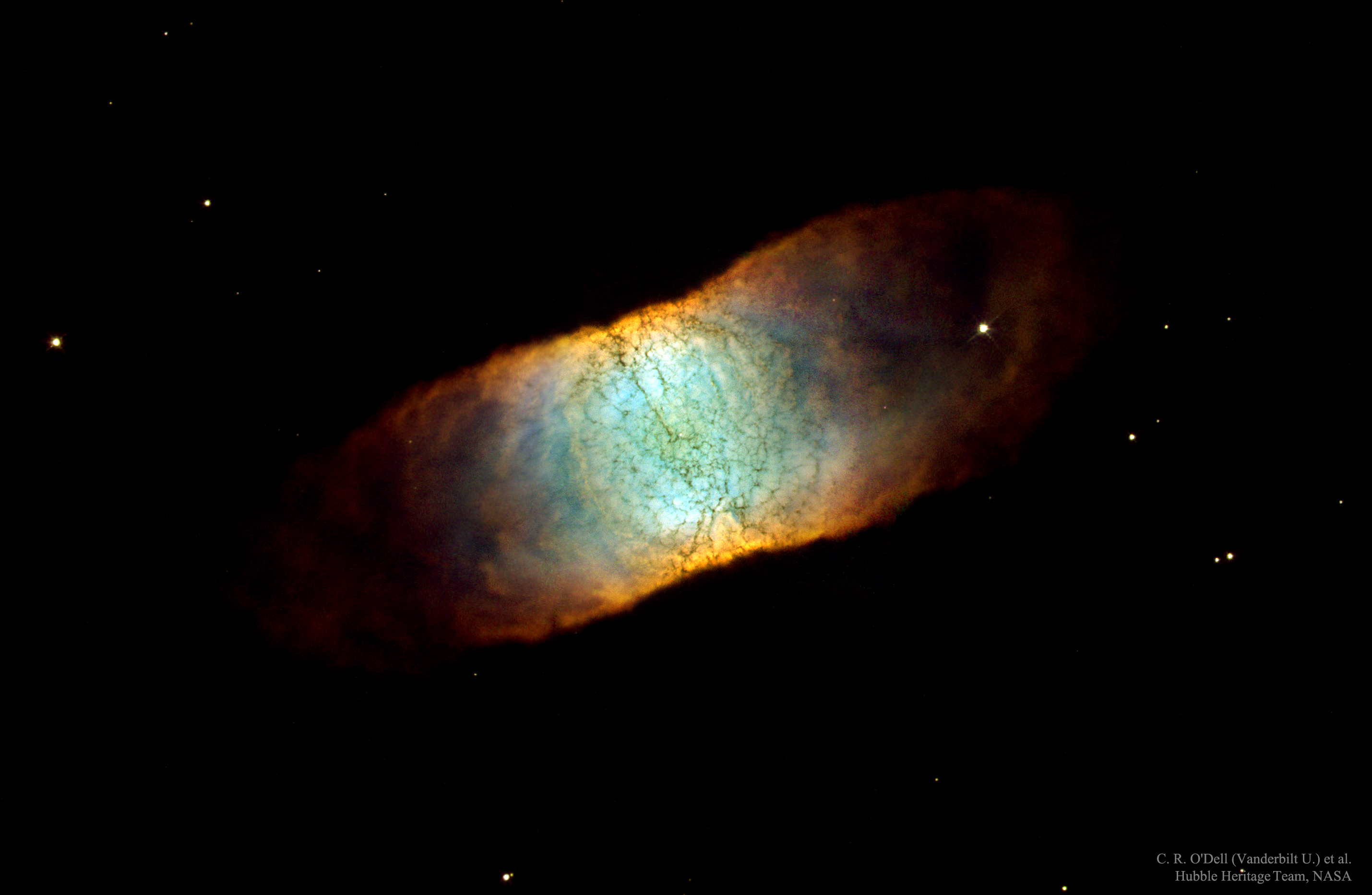
IC 4406: A Seemingly Square Nebula
Image Credit: C. R. O'Dell (Vanderbilt U.) et al., Hubble Heritage Team, NASA
Explanation: How can a round star make a square nebula? This conundrum comes to light when studying planetary nebulae like IC 4406. Evidence indicates that IC 4406 is likely a hollow cylinder, with its square appearance the result of our vantage point in viewing the cylinder from the side. Were IC 4406 viewed from the top, it would likely look similar to the Ring Nebula. This representative-color picture is a composite made by combining images taken by the Hubble Space Telescope in 2001 and 2002. Hot gas flows out the ends of the cylinder, while filaments of dark dust and molecular gas lace the bounding walls. The star primarily responsible for this interstellar sculpture can be found in the planetary nebula's center. In a few million years, the only thing left visible in IC 4406 will be a fading white dwarf star.

IC 4406: A Seemingly Square Nebula
Image Credit: C. R. O'Dell (Vanderbilt U.) et al., Hubble Heritage Team, NASA
Explanation: How can a round star make a square nebula? This conundrum comes to light when studying planetary nebulae like IC 4406. Evidence indicates that IC 4406 is likely a hollow cylinder, with its square appearance the result of our vantage point in viewing the cylinder from the side. Were IC 4406 viewed from the top, it would likely look similar to the Ring Nebula. This representative-color picture is a composite made by combining images taken by the Hubble Space Telescope in 2001 and 2002. Hot gas flows out the ends of the cylinder, while filaments of dark dust and molecular gas lace the bounding walls. The star primarily responsible for this interstellar sculpture can be found in the planetary nebula's center. In a few million years, the only thing left visible in IC 4406 will be a fading white dwarf star.

panosol- Αριθμός μηνυμάτων : 762
Points : 927
Reputation : 15
Ημερομηνία εγγραφής : 17/06/2012
Ηλικία : 56
 2017 January 9
2017 January 9
2017 January 9
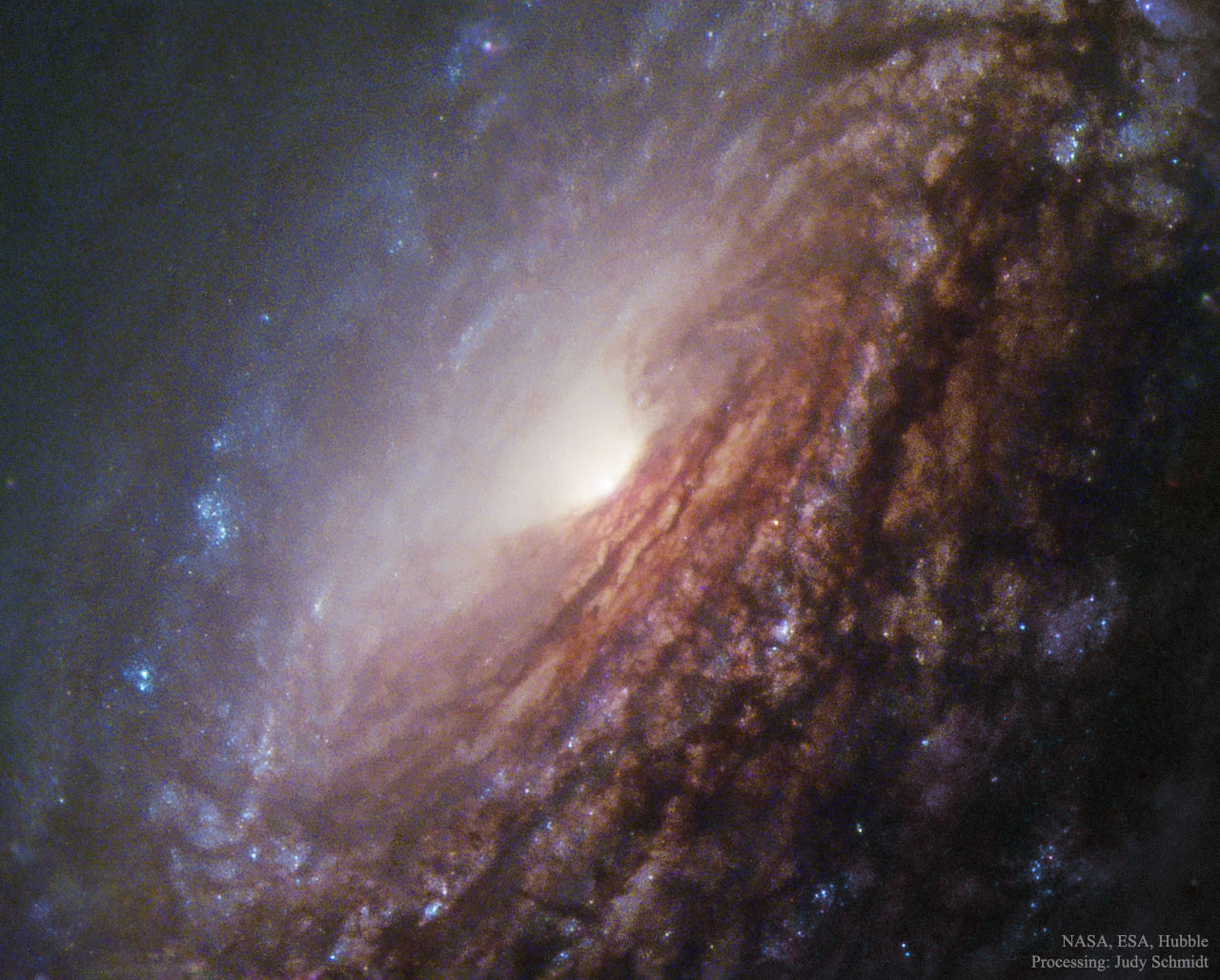
In the Center of Spiral Galaxy NGC 5033
Image Credit: NASA, ESA, Hubble, MAST - Processing: Judy Schmidt
Explanation: What's happening in the center of spiral NGC 5033? Many things -- some circular, some energetic, and some not well understood. NGC 5033 is known as a Seyfert galaxy because of the great activity seen in its nucleus. Bright stars, dark dust, and interstellar gas all swirl quickly around a galactic center that appears slightly offset from a supermassive black hole. This offset is thought to be the result of NGC 5033 merging with another galaxy sometime in the past billion years. The featured image was taken by the Hubble Space Telescope in 2005. NGC 5033 spans about 100,000 light years and is so far away that we see it only as it existed about 40 million years ago.

In the Center of Spiral Galaxy NGC 5033
Image Credit: NASA, ESA, Hubble, MAST - Processing: Judy Schmidt
Explanation: What's happening in the center of spiral NGC 5033? Many things -- some circular, some energetic, and some not well understood. NGC 5033 is known as a Seyfert galaxy because of the great activity seen in its nucleus. Bright stars, dark dust, and interstellar gas all swirl quickly around a galactic center that appears slightly offset from a supermassive black hole. This offset is thought to be the result of NGC 5033 merging with another galaxy sometime in the past billion years. The featured image was taken by the Hubble Space Telescope in 2005. NGC 5033 spans about 100,000 light years and is so far away that we see it only as it existed about 40 million years ago.

panosol- Αριθμός μηνυμάτων : 762
Points : 927
Reputation : 15
Ημερομηνία εγγραφής : 17/06/2012
Ηλικία : 56
 2017 January 10
2017 January 10
2017 January 10
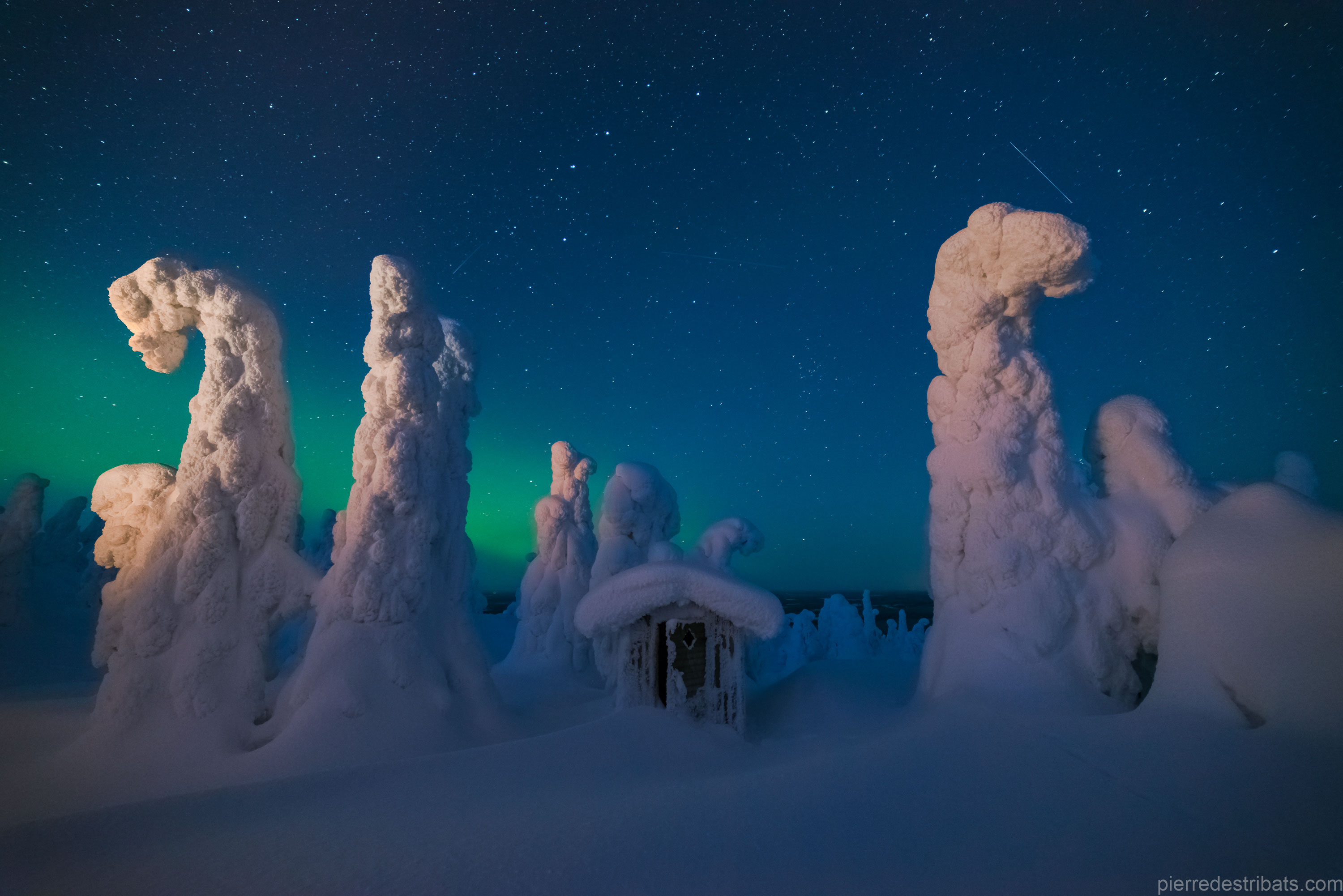
Sentinels of a Northern Sky
Image Credit & Copyright: Pierre Destribats
Explanation: Who guards the north? The featured picture was taken last March in Finnish Lapland where weather can include sub-freezing temperatures and driving snow. Surreal landscapes sometimes result, where white alien-looking sentinels seem to patrol the landscape. In actuality though, the aliens are snow-covered trees, and the red hut they seem to be guarding is an outhouse. Far in the distance, behind this uncommon Earthly vista, is a beautiful night sky which includes a green aurora, bright stars, and streaks of orbiting satellites. Of course, in the spring, the trees thaw and Lapland looks much different.

Sentinels of a Northern Sky
Image Credit & Copyright: Pierre Destribats
Explanation: Who guards the north? The featured picture was taken last March in Finnish Lapland where weather can include sub-freezing temperatures and driving snow. Surreal landscapes sometimes result, where white alien-looking sentinels seem to patrol the landscape. In actuality though, the aliens are snow-covered trees, and the red hut they seem to be guarding is an outhouse. Far in the distance, behind this uncommon Earthly vista, is a beautiful night sky which includes a green aurora, bright stars, and streaks of orbiting satellites. Of course, in the spring, the trees thaw and Lapland looks much different.

panosol- Αριθμός μηνυμάτων : 762
Points : 927
Reputation : 15
Ημερομηνία εγγραφής : 17/06/2012
Ηλικία : 56
 2017 January 11
2017 January 11
2017 January 11

Mimas, Crater, and Mountain
Image Credit: Cassini Imaging Team, SSI, JPL, ESA, NASA
Explanation: Mimas is an icy, crater-pocked moon of Saturn a mere 400 kilometers (250 miles) in diameter. Its largest crater Herschel is nearly 140 kilometers wide. About a third the diameter of Mimas itself, Herschel crater gives the small moon an ominous appearance, especially for scifi fans of the Death Star battlestation of Star Wars fame. In fact, only a slightly bigger impact than the one that created such a large crater on a small moon could have destroyed Mimas entirely. In this Cassini image from October 2016, the anti-Saturn hemisphere of the synchronously rotating moon is bathed in sunlight, its large crater near the right limb. Casting a long shadow across the crater floor, Herschel's central mountain peak is nearly as tall as Mount Everest on planet Earth.

Mimas, Crater, and Mountain
Image Credit: Cassini Imaging Team, SSI, JPL, ESA, NASA
Explanation: Mimas is an icy, crater-pocked moon of Saturn a mere 400 kilometers (250 miles) in diameter. Its largest crater Herschel is nearly 140 kilometers wide. About a third the diameter of Mimas itself, Herschel crater gives the small moon an ominous appearance, especially for scifi fans of the Death Star battlestation of Star Wars fame. In fact, only a slightly bigger impact than the one that created such a large crater on a small moon could have destroyed Mimas entirely. In this Cassini image from October 2016, the anti-Saturn hemisphere of the synchronously rotating moon is bathed in sunlight, its large crater near the right limb. Casting a long shadow across the crater floor, Herschel's central mountain peak is nearly as tall as Mount Everest on planet Earth.

panosol- Αριθμός μηνυμάτων : 762
Points : 927
Reputation : 15
Ημερομηνία εγγραφής : 17/06/2012
Ηλικία : 56
Σελίδα 1 από 15 • 1, 2, 3 ... 8 ... 15 
Σελίδα 1 από 15
Δικαιώματα σας στην κατηγορία αυτή
Δεν μπορείτε να απαντήσετε στα Θέματα αυτής της Δ.Συζήτησης|
|
|

 Αρχική
Αρχική Φόρουμ
Φόρουμ RADIO
RADIO ΠΑΙΓΝΙΔΙΑ
ΠΑΙΓΝΙΔΙΑ Latest images
Latest images Εγγραφή
Εγγραφή Σύνδεση
Σύνδεση




» ΚΑΛΗ ΑΝΑΣΤΑΣΗ ΚΑΙ ΚΑΛΟ ΠΑΣΧΑ!!
» Εφυγε από τη ζωή ο Τζίμης Πανούσης
» ΧΡΟΝΙΑ ΠΟΛΛΑ ΚΑΙ ΚΑΛΗ ΧΡΟΝΙΑ ΜΕ ΥΓΕΙΑ ΚΑΙ ΕΥΤΥΧΙΑ!!!
» This day in music
» Astronomy Picture of the Day
» Τις καλύτερες ευχές μου για Ευτυχισμένα Χριστούγεννα σε όλους!!
» ΖΗΤΩ Η 28η ΟΚΤΩΒΡΙΟΥ 1940
» ΖΗΤΩ Η 28η ΟΚΤΩΒΡΙΟΥ 1940
» Το τελευταίο αντίο στη Ζωή Λάσκαρη
» 19 Μαΐου: Ημέρα Μνήμης της Γενοκτονίας των Ποντίων
» Kαλό σου ταξίδι!!
» ΧΡΙΣΤΟΣ ΑΝΕΣΤΗ!!
» ΚΑΛΗ ΜΕΓΑΛΗ ΕΒΔΟΜΑΔΑ!!
» ΚΑΛΟ ΜΗΝΑ!!!
» ΧΡΟΝΙΑ ΠΟΛΛΑ!!
» ΧΡΟΝΙΑ ΠΟΛΛΑ!!
» R.I.P. Chuck Berry
» 8 Μαρτίου - Παγκόσμια Ημέρα της Γυναίκας
» ΧΡΟΝΙΑ ΠΟΛΛΑ ΚΑΙ ΚΑΛΗ ΣΑΡΑΚΟΣΤΗ!!